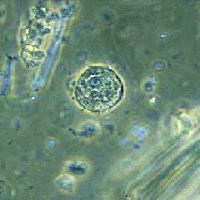Most often, Amebiaz occurs in countries with tropical and subtropical climates and low sanitary population. How can we get to be infected with amebiaise?
Content
What it is
 Amebiaz (amoebic dysentery) - disease caused by a single-cellular parasite of a histolytic Ameba (Entamoeba Histolytica). Parasite striking the colon. Found everywhere, but more often in countries with a hot climate.
Amebiaz (amoebic dysentery) - disease caused by a single-cellular parasite of a histolytic Ameba (Entamoeba Histolytica). Parasite striking the colon. Found everywhere, but more often in countries with a hot climate.
Ameba may exist in two forms:
- The tropho is an active form, inhabites in intestinal content, outside the human body is not liable.
- Cyst - an inactive form, precisely using cysts by the distribution of Amebiaz.
Tropozoites can cause diarrhea (diarrhea) and thus output from the human body. If diarrhea does not develop, the trophozoites become solid cysts, which are derived from the feces.
Infection occurs when contact with infected feces, which is possible with bad hygienic and sanitary conditions, with sexual contacts with an infected person.
What happens
Often the symptoms of Amebiaz are so uncertain that a person can live with this disease for years and not pay attention to him. It can be diarrhea, meteorism, abdominal spasms, blood can appear in feces, possibly at times a small increase in body temperature.
Gradually, a person can develop exhaustion (cachexia) and anemia (decrease in the hemoglobin conversion - the main carrier of oxygen - in human blood).
With the worst version of the development of events, the trophozoites are introduced into the intestinal wall. In this case, the destruction of the epithelium arises (clics of the outer bed of the intestine, the bowel liner), damage to the blood vessels of the intestine and the formation of deep ulcers. This is manifested by pain in the stomach, frequent inherent defecates (feces) with a lot of mucus and blood (up to the species «Raspberry jelly»), temperature rise, total weakness, loss of appetite.
Sometimes a tumor-like education is formed - Ameboma, which can lead to intestinal obstruction.
If the trophozoids penetrate through the intestinal wall, it is fraught with inflammation of the peritoneum (covers our intestines) - peritonitis.
Penetration of trophozoites in the fabric of the appendix can lead to a light form of appendicitis. It is dangerous in that when the operation to remove appendix, there is a risk of parasites in the abdominal cavity, therefore, the operation is usually postponed for two-three days, during which the patient is treated with drugs to destroy parasites.
Tropocoites may also hit the liver, through blood flow to infect light, brain and other organs.
As determined by Amebiaz
To identify Amebiaza take feces analysis. Perhaps it will be necessary to perform from 3 to 6 studies. In addition, the inspection of the inner surface of the rectum is carried out with a reorganosososcopy (research method: inspection of the inner surface and colon cavity using a special apparatus with optical and lighting systems).
Treatment appoints only a doctor and only on the results of the tests. After 1, 3 and 6 months after treatment, repeated feces are carried out in order to make sure the therapy efficiency.









